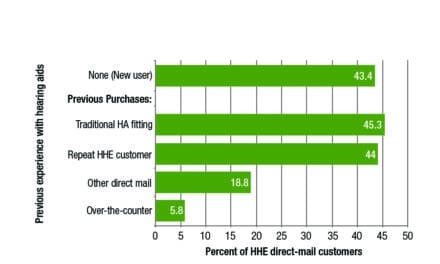The European Hearing Instrument Manufacturers Association (EHIMA) announced 6.4% growth in global hearing aid sales for 2019. The six EHIMA member companies which are manufacturing hearing aids (Amplifon, Demant, GN Hearing, Sonova, Starkey, and WS Audiology) account for more than 90% of the global hearing aid production, according to EHIMA’s announcement. In 2019, they sold 17,058,000 hearing aids to their retail customers (audiologists and hearing care professionals). This number does not entail other hearing instruments, such as implants.
| Global Unit Sales | |
| 2019 | 17,058,000 (+6.4%) |
| 2018 | 16,035,000 (+6.5%) |
| 2017 | 15,054,000 (+5.7%) |
Source: EHIMA data
As for the current year, due to effects of the coronavirus pandemic, the entire industry has experienced a significant drop in demand.
“From the beginning of the lockdowns until end of June we saw a dramatic global market decline,” said EHIMA President Søren Nielsen. “The entire hearing care ecosystem is suffering severely.”

In the long term, demand for hearing instruments is high. This is proven by regular representative surveys on hearing loss and hearing aid uptake in 15 countries. For instance, between 2009 and 2018 around 13% of the adult population in Germany, France, and the UK consistently report having a hearing impairment. In the same period, the adoption of hearing instruments in these countries grew from 33% to 42%.[1]
Still, there is unmet need. According to an international meta-study, around 22.6 million people in the European Union live with untreated, disabling hearing loss, leading to annual costs of 185 billion Euros.[2] A growing uptake of hearing aids not only contributes to lowering these costs; representative studies in 15 countries confirm that more than 96% of people fitted with hearing aids report a higher quality of life.[3]
“Hearing aids today provide a wealth of benefits, such as wireless connectivity to smartphones and TVs. Also, more and more people understand that timely, professional treatment of hearing loss can reduce other health risks, such as cognitive decline and dementia,” said Nielsen. “Together, with medical experts, we therefore strongly advise not to delay necessary treatment. Those unable or unwilling to seek on-site treatment from a hearing care professional under the current circumstances, can benefit from a wide range of remote care and tele-audiology services offered by EHIMA member companies.”
The European Hearing Instrument Manufacturers Association (EHIMA)
The European Hearing Instrument Manufacturers Association (EHIMA) represents the world’s seven major hearing instrument manufacturers, offering smart hearing aid and implant solutions for people hard of hearing. EHIMA was founded in 1985 and its members are among the world’s largest and most advanced hearing instrument manufacturers. Members of EHIMA develop, manufacture, and market hearing instruments on a large scale in one or more countries in Europe as well as exporting their products worldwide.
Key Facts on Hearing Loss
- 1 in 10 of the total EU population states a hearing loss.*
- Only 1 in 3 of the hard of hearing people uses hearing instruments.*
- Untreated hearing loss costs EU28 each year 185 billion €.**
- Hearing instruments help to reduce these costs.**
[1] EHIMA. EuroTrak Country Market Surveys. https://www.ehima.com/eurotrak/.
[2] Untreated hearing loss in the EU costs more than the whole EU budget. Hear-it.org. https://www.hear-it.org/untreated-hearing-loss-eu-costs-more-whole-eu-budget. Published February 25, 2019.
[3] EHIMA. EuroTrak Country Market Surveys. https://www.ehima.com/eurotrak/.
Source: EHIMA




